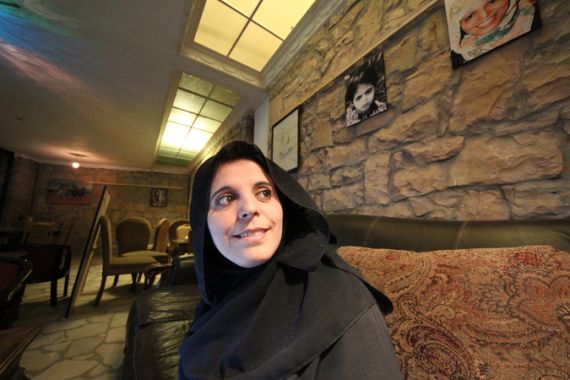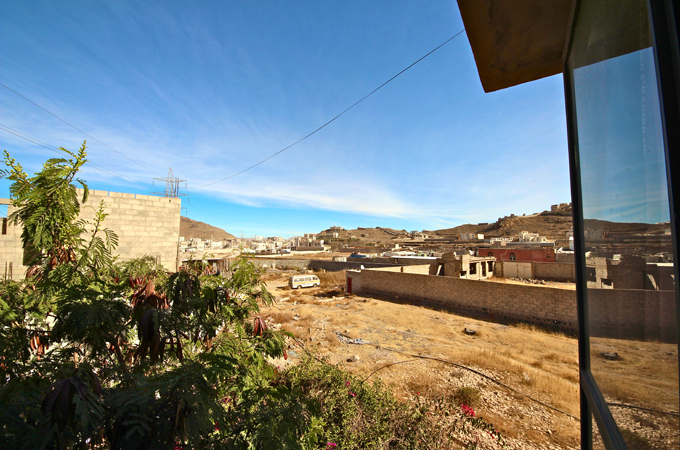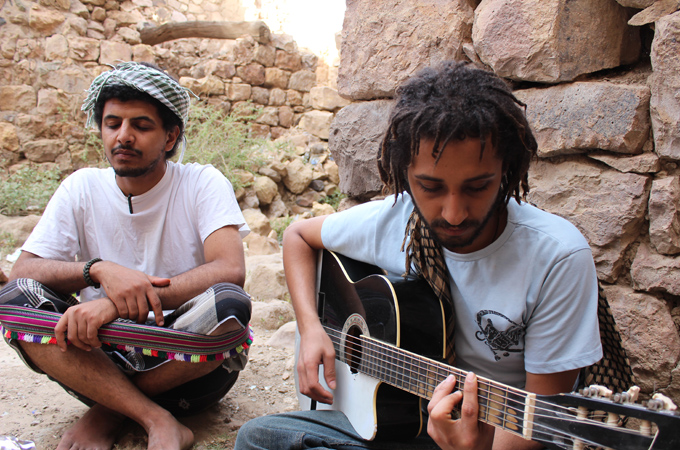Safe space for art strikes a chord in Yemen
A vibrant art gallery and an activist rock band have been creating a stir in this conservative Arab country.

Sanaa, Yemen – Yemeni entrepreneur Taysir al-Sharki reaches into her self-designed purse embellished in sitara fabric – a pattern usually reserved for old women’s dresses – to pull out her ringing mobile phone.
But an old woman she is not. The 42-year-old Sharki greets the caller while pouring tea for the dozen artists gathered in her vast new art gallery in Yemen’s dusty capital.
Keep reading
list of 4 items‘Accepted in both [worlds]’: Indonesia’s Chinese Muslims prepare for Eid
Photos: Mexico, US, Canada mesmerised by rare total solar eclipse
What is a Godzilla anyway? The 70-year-old monster behind the movies
The excited chatter of the young artists gathered in the Raufa Hassan Gallery stops as they see Sharki’s face drop. A Yemeni security official is the caller. Rumours have been swirling that her art gallery is actually an illicit nightclub, they say. Officers will be paying her a visit soon.
Meanwhile, Omr Sa’d – the harmonica player for 3 Meters Away – the activist band in residence at the gallery – notices his own phone ringing. Sa’d already knows the call is bad news: the unknown number is a member of his large, conservative family who is threatening his life for playing rock music.
Finally, Sharki hangs up her phone, looking daunted. Her hands shake as she finishes pouring tea. “What can I say? This is Yemen,” she says, a grim smile crossing her face.
A sister’s dream deferred
Even before founding the gallery in late 2012, the woman affectionately known as Madame Taysir has always pushed boundaries. After all, it runs in her family.
 |
| Gallery on the outskirts of the capital [Gaar Adams/Al Jazeera] |
Sharki’s late sister, Raufa Hassan, for whom the gallery is named, broke new ground during her short life. She was the first female journalist in the country, the founder of the media college and the Center for Women’s Studies at Sanaa University, and a tireless advocate for women’s rights.
But Hassan’s untimely death from cancer in April 2011 – in the midst of the Arab Spring and Yemen’s most tumultuous period in decades – left Yemen without one of its most charismatic moral compasses.
“At a time on the national stage when talk was just politics, politics, politics, Yemen missed Raufa’s voice. Yes, she cared about [politics], but in a way that included talk of culture and art and community,” Sharki says. “At such an important moment in our country, I couldn’t let her voice die with her.”
To continue her sister’s work, Sharki turned a large three-storey stone house on the southern outskirts of Sanaa, designed by Saba al-Suleihi, a Yemeni MIT architecture graduate, into a space filled with the things Hassan loved: art, culture, music.
It was a perfect find – the house was already frequented by a loose confederation of Yemeni intelligentsia – and so Sharki moved to fully take over the space.
“I came from an open-minded family from the Old City in Sanaa. I think I was the first kid in my neighbourhood with ripped jeans,” Sharki laughs. “My family encouraged learning and intellectual curiosity – look what that did for my sister. So I wanted to create a place where the whole community could have that same opportunity for openness.”
Building upon the previous owner’s efforts, Sharki worked to realise her own vision of a vibrant artistic salon in Yemen. She hung the work of local artists and displayed the paintings her sister had collected during her travels abroad. She brought in Yemeni history and coffee-table books that celebrated the country’s vibrancy. As a final touch, she included a coffee shop and displayed a small exhibition dedicated to her late sister’s work.
But though she successfully navigated the minefield of bureaucracy to establish the gallery, Sharki soon learned the road to acceptance was far from complete.
Calls from various government security apparatus began soon after the gallery’s founding, Sharki says. Some artists participating in weekly salons at the gallery were perhaps too vocal during the anti-government protests of 2011-12, she adds.
Then word got out about the mixed-gender nature of the gatherings. Soon, gossip intensified that Sharki was running a place of immorality.
One day in January, Sharki’s mother called her in tears. “Her neighbour told her that she heard her daughter was running a dance club,” Sharki recalls. “She pleaded to me, ‘Do what you want but please take your sister’s name off of it’. I didn’t know what to do.”
After all her work to honour the memory of her sister, Sharki was heartbroken.
Yemen’s only activist rock band
In over her head with controversy and struggling to pay the $800 monthly rent, Sharki recruited a group who could help save the gallery and already had plenty of experience with criticism – 3 Meters Away, Yemen’s only activist rock band.
After spending part of 2011 abroad upon receiving threats from pro-government forces, 3 Meters Away returned to Sanaa in early 2012 with a series of triumphs: international publicity, invitations to perform in Europe, and plans to record their first full-length album, “Insan”.
But the triumphs were soon followed by bigger hardships – for singer Ahmed Asery, continued threats from Yemeni authorities; for drummer Shadi, an attack allegedly at the hands of security forces for playing anti-government music; and for Sa’d, continued death threats from his conservative family for playing in a rock band.
So, in late 2012, the band left Sanaa again. But this time, they decided to bring their music to another part of Yemen: Abyan, a southern governorate overtaken by al-Qaeda-linked groups in early 2011.
3 Meters Away quickly devised a 10-day tour to several villages in Abyan, which included a football match to rally the communities, performances showcasing their activist songs, and free workshops at schools in theatre, photography, and writing.
 |
| The Abyan tour was ‘about spreading critical thinking in a place where this isn’t allowed to be much of that’, says Sa’d [Gaar Adams/Al Jazeera] |
“The Abyan tour was our chance to take our message even further and bring it right to the people who need to hear about peace and equality and love the most,” Sa’d explains. “It was about spreading critical thinking in a place where there isn’t allowed to be much of that.”
The response was overwhelmingly positive. But when they returned to Sanaa, their landlord kicked the band out of their house for playing music and inviting over girls. After the tour, 3 Meters Away was broke and homeless.
Fortunately, al-Sharki heard them playing at a coffee shop in Sanaa. “I was not going to let these kids lose their future for trying to help our country,” she explains.
So Sharki devised an artist-in-residence program – 3 Meters Away would pay subsidised rent at Raufa Hassan Gallery, and have a place to live and perform without fear, if they could help bring the gallery more attention.
The group devised a programme called Raufa Hassan Artist Camps, a forum where artists can come together, generate ideas, and talk through their work. “We wanted a place that was a forum for creativity and problem-solving for the community, not just a place to talk about political issues,” Sa’d explains.
Sharki and the band also instituted a weekly salon where artists could present their work and feed off one another’s creative energy.
“The artist camps are about giving people a voice and teaching them how to use it,” Shadi says. “In the South when we toured Abyan, people felt unheard. We didn’t want all of the youth in Yemen feeling that same way.”
As UN-backed talks to prepare the country for democratic elections next year began last week at the posh Movenpick Hotel in northern Sanaa, 3 Meters Away is leading its own conversation on the other side of town. Rejected from formal inclusion as a delegate in the National Dialogue, Asery thinks engaging youth in grassroots discussion is more important than ever.
“The real National Dialogue is happening here anyway,” Asery says, helping a group of teenage boys from the Old City write their own song. “If we don’t talk to kids in intelligent ways, someone else may talk to them in more violent ways.”
A work in progress
The Raufa Hassan Gallery is a breath of fresh air for local artists who see it as one of their few havens.
Methal Hamadi, who attends the gallery’s artist camps and jam sessions with a pink guitar slung over her back, is grateful for a place where her creativity is celebrated – much to the dismay of her mother, who thinks she should focus on her medical studies at Sanaa University.
For Ahmed Haidar, a scrawny 16-year-old who learned to play piano from YouTube and keeps a dusty Casio keyboard at the gallery, his improvisations are largely inspired by his trauma at Sanaa’s Change Square on the Day of Dignity when, on March 18, 2011, snipers loyal to pro-government forces opened fire on protesters and shot dead at least 45 people. Haidar says he watched an elderly man die and helped drag the dead and wounded out of the line of fire.
Recent flooding on the unpaved roads around the gallery may force Sharki to find a new location. But for Sharki, who has been heartened by recent support from the Ministries of Culture and Social Affairs for her International Women’s Day and Mothers’ Day programmes at the gallery – the location isn’t what matters most.
“Wherever the gallery may be, it is a place that Yemen should take pride in,” Sharki beams.
Follow Gaar Adams on Twitter: @GaarAdams